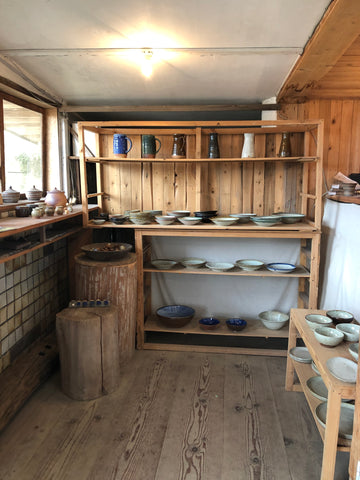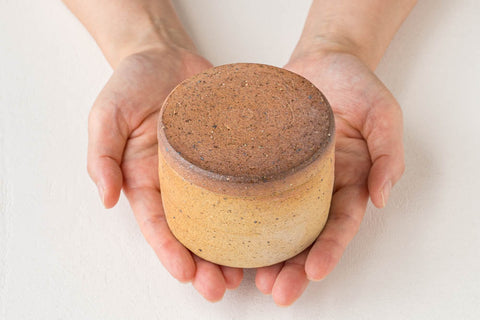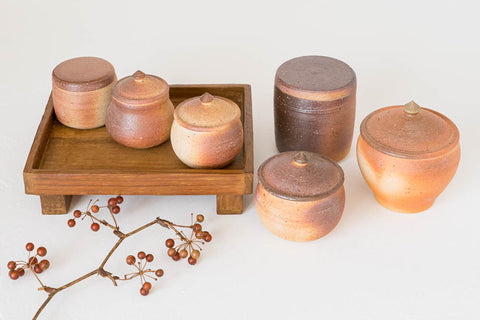Introducing Kawajiri Pottery's lovely salt and sugar jars that the owner fell in love with at first sight!

I visited "Kawajiri pottery" in Mashiko around the time of autumn.

Kawajiri Pottery, located in Mashiko, Tochigi, is a climbing kiln that was built by the father of Takuya , who is currently in charge of the kiln. Mr. Takuya describes such a climbing kiln as an “endangered species.” Considering the main kilns currently in operation, only one remains in each of the ceramic production areas in Japan.
The father, who is the founder, is said to be "a person who can make anything", so he built the climbing kiln together with the craftsmen. It's amazing to hear that the workshop and store have almost been built!


A cute shop next to the workshop. You can directly see the various baked colors and textures.

The shop has a warm atmosphere.


Mr. Takuya Kawajiri, who is the second generation, studied at the Tochigi Prefectural Ceramics Technology Support Center in 2006, and then learned how to fire climbing kilns at Kitagama Yonahara Studio in Okinawa . In Okinawa and Kyushu, there are still many techniques that have been used since ancient times, and there are many things to learn.
Cute sign made by Mr. Kawajiri at the entrance to the climbing kiln.

It is said that there are about 40 climbing kilns in Mashiko, but most of them are not used (including those that have not been used since they were destroyed in the 2011 earthquake), or they are said to be used about once a year. Kawajiri Pottery is the only company that is particular about climbing kilns and is always in operation.
kiln entrance. A scenic view with beautiful nature.

We take out the kiln on a schedule of about once every two months.

Since the fuel uses waste wood in different conditions, it takes time and effort to sort and chop firewood.

Inside the climbing kiln. While making use of the heat of the next room, put fuel (firewood) in each room and bake while adjusting.

Peephole inside the kiln.

A small sample product is inserted into this hole to check the firing condition.
The climbing kiln cannot be completely oxidized (fired in a state with a lot of oxygen) or reduced (fired in a state with little oxygen), so it is fired while making fine adjustments with a sense of oxidation or reduction. Even within the same kiln, there are some that are slightly oxidized, while others are slightly reduced. Natural changes appear in the vessel, creating a beauty that cannot be found in gas kilns or electric kilns.

In the kiln, the fire flows from one side, so Mr. Kawajiri thinks that there are things that are suitable for making. Using the coarse soil of Mashiko, he creates pottery with the idea of making it a "special product".
salt pot

Mashiko soil, which has a lot of sand, is used, so it naturally adjusts the moisture inside. In addition to salt, ginger and garlic are also perfect. The soft scarlet color (scarlet) is wonderful with an indescribably rich expression.

sugar urn

The inside of the sugar urn is glazed and has the effect of trapping or trapping excess moisture. In addition to sugar, it would be nice to add preserved foods such as pickled plums, shallots, and fresh ginger and serve them as they are.

The climbing kiln is both a feature and an attraction, but individual differences in color appear depending on the location of the kiln.

*On the product page, you can choose the baking color using the alphabet.
A spice mill that makes use of the rough soil of Mashiko

The rough surface allows you to grind moderately.

Compared to the electric kiln, gas kiln, and kerosene kiln that many kilns use, it is affected by natural conditions, so it takes more time and effort to bake, and there is a lot of loss (items that cannot be sold as products). not. However, the created work will have a warm and tasteful baked color, and it will have a texture that cannot be seen elsewhere.
“In the old days, everyone used climbing kilns, so there is no such thing as a special technique. But if that happens, I probably won't do pottery," said Takuya.
Started making pottery in Mashiko about 10 years ago. However, one year later, in 2011, half of the kiln was destroyed by the Great East Japan Earthquake. Even though half of his own kiln was broken, he went to repair broken climbing kilns here and there with his father. It seems that he was very busy because there were not many makers of climbing kilns.
“I would like more people to do climbing kilns.
Mr. Kawajiri is an honest and sincere person who answered all our questions very politely. I felt a deep affection for the climbing kiln after talking to you. I look forward to seeing your wonderful works!
Kawajiri Pottery (stand)
4327 Mashiko, Mashiko Town, Haga District, Tochigi Prefecture 321-4217
Click here for items from Kawajiri Pottery 
